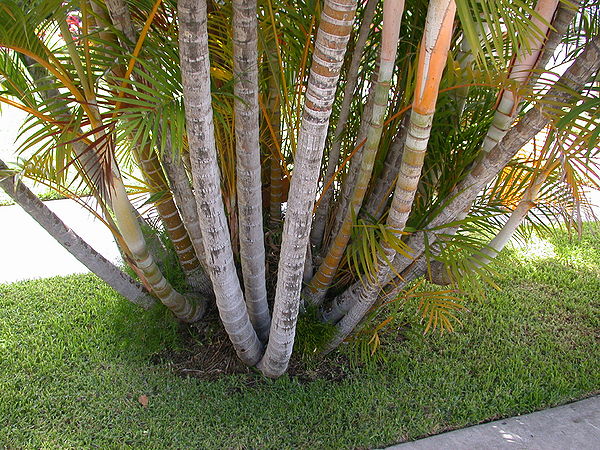Pronunciation: DIP-siss loo-TESS-enz
Common Name: Areca Palm, Butterfly Palm
Dypsis lutescens may be one of the most commonly available palms in southern California, but a mature specimen rarely fails to impress observers. This Madagascan palm is often sold as indoor palm in garden outlet centers, but in fact tends to be a poor palm for such situations (needs too much light to be happy indoors). It is a densely suckering palm, often used for visual screens in Hawaii and south Florida where it grows VERY fast and some consider this a weed. However, it grows MUCH more slowly in California and does NOT make a good visual barrier, but is still fantastic looking plant.
Synonym: Chrysalidocarpus lutescens
|
Appearance and Biology
- Habit: suckering with a crown of about 5-7 arching leaves
- Height: 20' tall
- Trunk: multiple (new shoots constantly growing); strongly ringed, yellow-green to woody; often arching outward form the center of the plant; 4" thick
- Crownshaft: 18" long; pale green to yellow-orange with age (before leaf falls off); slightly wider than trunk
- Spread: 8'-20'+
- Leaf Description: pinnate; strongly recurved with upright leaflets, often with a characteristic bend near their tips (particularly in tropical situations); 4'-5' long; light green to yellowish with age of leaf
- Petiole/Leaf bases: 1' long; nearly tubular; unarmed; yellowish near base where it gets a speckled look and sometimes has sparse black fuzz
- Reproduction: monoecious
- Inflorescence: arising right below crownshaft, arching downward 1'-2' long and somewhat branched, yellow flowers (separate female and male on same inflorescence)
- Fruit: 1" diameter, nearly spherical and green to yellow-orange with mature
|
Horticultural Characteristics
- Minimum Temp: 26F
- Drought Tolerance: moderate
- Dry Heat Tolerance: moderate to good
- Cool Tolerance: moderate
- Wind Tolerance: moderate
- Salt Tolerance: moderate
- Growth Rate: slow to moderate with age
- Soil Preference: very adaptable to variety of soils
- Light Requirement: full to partial sun
- Human Hazards: none
- Disease or Horticultural Problems: tendency to have potassium deficiency in some soils
- Transplants?: fairly good
- Indoor?: relatively poor, though tried over and over again
- Availability: very commonly available
|

































